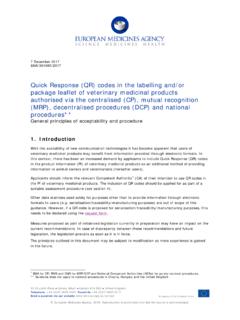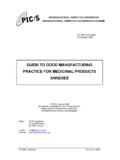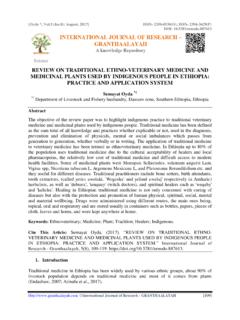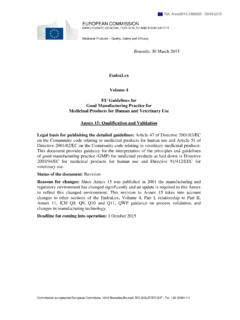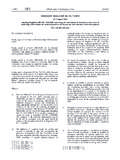Transcription of VICH and its role for authorisation of veterinary ...
1 Secretariat : c/o IFAH, rue Defacqz, 1 - B - 1000 Bruxelles (Belgium) - Tel. +32 2 543 75 72, Fax +32 2 543 75 85 e-mail : - Website : VICH/10/008 5 May 2010 Final VICH and its role for authorisation of veterinary medicinal products Executive Summary Many countries have legislation to ensure at least minimum standards to establish the quality, safety and efficacy of veterinary medicinal products. Work is ongoing through several organisations involved with cooperation between countries to harmonise requirements and to simplify processes regarding veterinary medicinal products. The goal is to allow equal access to safe and efficacious veterinary medicines around the world. The International Cooperation on Harmonisation of Technical Requirements for Registration of veterinary medicinal Products (VICH) is an ongoing programme to harmonise technical requirements for marketing authorisations for veterinary medicinal products.
2 This document aims to summarise the principles of a registration/ marketing authorisation system, to describe the VICH role and to explain the process to develop harmonised VICH guidelines. 1. Principles for the registration / authorisation of veterinary medicinal products What is a marketing authorisation / registration? As a general rule, before a veterinary medicinal product can be sold or used, it must be authorised by the responsible authority of the country where it will be used. This applies to all types of veterinary medicinal products, pharmaceutical products as well as vaccines and other immunological products. A marketing authorisation (also called registration or licence ) is the approval by the responsible authority in the country concerned that the product can be sold and used, specifying the details of the medicine ( name of active substance, animals for which it can be used, indications for use, dose and duration of treatment), the conditions of use ( storage conditions, shelf life, withdrawal period, instructions for safe use or instructions for safe disposal of waste) and any precautions or warnings for safe use, including possible contraindications.
3 These details and instructions for use of a veterinary medicinal product are part of the labelling and package leaflet of the product , as it is brought on the market. What is necessary for setting up a marketing authorisation scheme? It is the responsibility of governments to establish a regulatory system for the authorisation and control of veterinary medicinal products. For this a law or other legal act Page 2 setting out the procedure and requirements for marketing authorisations, the process for distribution of the veterinary medicinal products and the system for control is necessary. The governments then need to have the instruments to implement the legislation. Many countries/regions have therefore regulations and published guidance documents that outline the testing requirements and standards for the data required to obtain a marketing authorisation /licence for a veterinary medicinal product in their country/region.
4 How can a company obtain a marketing authorisation (or registration or licence ) for a veterinary medicinal product ? In order to obtain a marketing authorisation (or registration or licence, as appropriate) the company that will bring the product on the market (also called sponsor or applicant) must submit an application to the responsible authority in the country concerned. The application should be accompanied by a comprehensive package of data on the quality, safety and efficacy of the veterinary medicinal product , be it either a pharmaceutical product , a vaccine or other immunological product . This data package is often called the dossier . The data in the application should confirm that the medicine is effective and safe when used in the proposed animal species for the proposed claims.
5 The application should also address any precautionary measures to be taken when storing the veterinary medicinal product , administering it to animals, disposing of waste of the medicine together with an indication of potential risks that the product might pose to human and animal health and to the environment. In the case of medicines used in food-producing animals, information on the time when it is safe for the consumer to eat animal products (such as milk, meat or eggs) following treatment or the end of treatment period (also called withdrawal period ), should be provided. Following the initial scientific assessment of the application, additional questions usually arise ( List of questions or Incomplete letter ) that the sponsor (or applicant) of the veterinary medicinal product will have to answer.
6 Once all questions have been satisfactorily answered and it is established that there are no risks that would outweigh the efficacy and other benefits of the veterinary medicinal product , the responsible authority can issue a marketing authorisation , imposing specific conditions of use, storage and waste disposal, as appropriate, for the specific product . As the process of reviewing all scientific data requires a large amount of resources, countries may wish in some instances to rely on assessments already carried out for the same medicine by the authorities in other countries, at least for some parts of the dossier, the safety and efficacy documentation. It is therefore important to know in which countries marketing authorisations have already been issued.
7 Information and assessments of authorised veterinary medicinal products can be found at the web pages of the regulatory authorities for many countries. Addresses for the web pages of VICH member countries and regions are given in Annex I to this document. Examples of the legislation and guidance established by the VICH members, the European Union, Japan and the USA are presented in Annex II to this document. Page 3 What should be included in an application dossier ? A full application for a marketing authorisation would normally comprise a comprehensive data package with quality documentation, safety data (including target animal safety data), residue data (residue depletion data for products indicated for food producing species) and efficacy (also often called pre-clinical and clinical documentation).
8 The application dossier should also provide administrative details, name of the product , name of the active substance(s), pharmaceutical form, name and contact details of the applicant, details on the manufacturer or importer, and a description of how the finished product appears when it is brought onto the market. Also the composition of the medicine and pharmaceutical details of the product should be provided. An example of an outline for such a dossier is described in Annex III. What else is important to ensure that veterinary medicinal products are safe and efficacious? The active substance(s) and the veterinary medicinal product should be manufactured under conditions that ensure that the resulting medicinal product has the appropriate quality and complies with the required standards.
9 As a second step, systems need to be in place that will ensure continued monitoring once the medicine has been approved and is being manufactured and marketed. Therefore, as example, the legislation in VICH countries requires a manufacturing authorisation certifying that the product is manufactured in compliance with Good Manufacturing Practice (GMP). Following marketing authorisation , products are monitored by a combination of pharmacovigilance (monitoring adverse drug reactions), sampling and testing of products on the market, and regular inspections of manufacturing sites. Also, VICH countries require monitoring systems to assure that compliance with the maximum residue limits for residues from veterinary medicinal products in foodstuffs from animal origin is controlled and surveillance schemes have been set up in the VICH countries as well as many other countries.
10 The residue surveillance concerns both food of animal origin produced by the country / region itself as well as imported foodstuffs. 2. About VICH What is VICH? VICH is a multinational (EU-Japan-USA) programme aimed at harmonising the studies and data that are requested by the authorities of the countries and regions that are part of VICH for veterinary product marketing authorisations. The full title is the International Cooperation on Harmonisation of Technical Requirements for Registration of veterinary medicinal Products. VICH was officially launched in April 1996. For more details see the VICH website at: Page 4 The launching of VICH followed an earlier international harmonisation activity on technical requirements regarding medicinal products for human use, the International Conference on Harmonisation of Technical Requirements for Registration of Pharmaceuticals for Human Use (ICH), which held its first meeting in 1991, and other harmonisation activities for veterinary medicines, in particular those coordinated by the World Organisation for Animal Health (OIE), Codex Alimentarius and the Joint FAO/WHO Expert Committee of Food Additives (JECFA).










